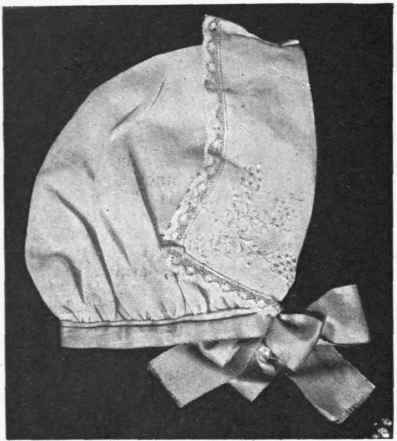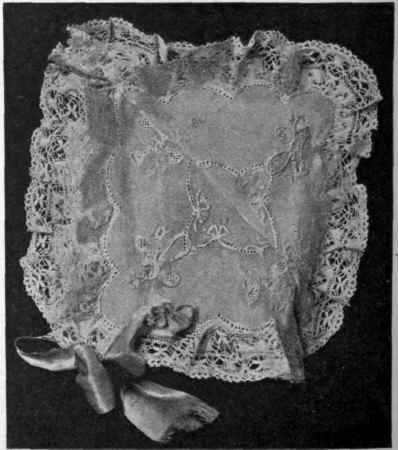2. Needlework Pictures. Continued
Description
This section is from "Every Woman's Encyclopaedia". Also available from Amazon: Every Woman's Encyclopaedia.
2. Needlework Pictures. Continued

No. 4. A winter scene. An embroidered picture in which linens of various colours are utilised to produce the desired effects
A good effect is obtained by mounting this picture on a slightly raised block of wood, like the wooden button mould, but 4 inches in diameter, the exact size of the picture. Such pictures have frequently been used to hang over the children's cots, or can be set into the woodwork itself if the bed is being made to order.
This picture would be eminently suitable for the cover of a favourite Bible or Prayer-book, and the skilful worker would probably surround it with a frame of gold thread in brick-stitch, and fill the corners for the oblong book with a small diaper pattern, or with emblems, such as lilies or small crosses of the Maltese shape. Such a work would interest the amateur bookbinder, who, in attempting embroidered examples, so often fails to obtain a good result through the poverty in design of the embroidery.
The personal element in needlework pictures is so attractive that many women are now" working their own or their children's portraits. The first step towards this delightful type of embroidery is to visit the studio of one of those photographers who make a specialty of the quaint eighteenth century background of garden vista or stone-seated terrace, which lends itself so well as a frame for a Gainsborough or Romney frock of soft satin muslin and flowing chiffon scarf. This picture is either printed on to sensitised silk, dull white or old ivory in colour, or it is copied on to the silk or .satin in water-colour. The lines are then embroidered on to the silk, and the portrait worked in stitchery. In such cases the face, neck, hands and arms are nearly always put in colour- tint with the brush the dress, foliage, and ground alone bring embroidered. Painstaking workers also put in the sky in stitches,but this is optional.
Picture on l.inen
Another method of embroidering pictures utilises different coloured linens in giving the effect. The illustrations Nos. 2 and 4 show examples of this type. In No. 4 the sky is of grey linen, and shows between the darning of orange, golden and red rays of the setting sun, which form so excellent a back-ground for the bare-branched trees. At the horizon white linen is joined on. Grey silk gives the effect of snow on the distant field. This is lightened in the middle dis-tance, and the white linen is shown beneath the feet of the red-clad figure in the foreground. With these simple materials real atmosphere is obtained, and an artistic picture the result.
The interior, with the peasant knitting (No. 2), is another example of the joining of coloured linens and the utilising of their colour in the embroidery scheme.
Green linen surrounds the window and forms the shutter. The window itself is of white linen, the Wall behind the figure of grey. There is blue linen beneath the window.
The figure being worked "solid," it is immaterial what canvas is beneath the closely set stitches. The broad effect of sunlight streaming in from the curtained window is cleverly carried out, and the peasant cap, toil-roughened hands and clog-shod feet and patient face accord well in simplicity with the artistic setting of the pathetic figure in its simple environment.
A Quickly-wrought Example
The last example is a monochrome study on brownish canvas. No stitches indicate the sky, so that we judge that it is cloudless, and the scarcely perceptible ripple of the water bears out this fact. Excellent efffect is obtained by the strong, dark, horizontal line of the fishing-boat mast in the foreground.
The effect of middle distance is obtained by the medium tones of the masts and sails of the large schooner in the background; the wharf and buildings show almost white. Eight shades of brown, from darkest umber to nearly white, are used; and the whole picture might be sketched in and worked from a coloured picture, or from the scene itself, in a day.
Many women are having colour sketches of favourite nooks in their gardens work out in needlecraft. The idea is essentially feminine and dainty, and is likely to be very largely adopted by those whose refinement and artistic sense lead them to recognise the beauty of essentially feminine achievement.
Bibs & Bonnets Out Of Handkerchiefs
Bonnet with Turned-back Rever - A Dainty Dutch Bonnet - A Quickly-made and Pretty Bib-further Suggestions for Using Embroidered Handkerchiefs
Women who are clever with their needle can make all sorts of pretty things for themselves and their children out of handkerchiefs. Here are a few ideas that may prove useful.

A very becoming baby's bonnet made from an embroidered handkerchief
Bonnet with Rever in Front
The first bonnet has a turned-back rever in front, To make it, a handkerchief with a little embroidery, and perhaps drawn-thread work at the corners only, is the most suitable kind. It need not be lace-edged, but in that case a little narrow lace may be sewn at the edge of the front rever. Start a running thread about 2 1/2 inches from one of the corners which is to be turned back to form the rever, and run it round to the same position on the opposite side of the handkerchief. Draw up this thread and cut off the hanging corners. Sew the gathers into a narrow band of muslin 9 inches in length. Stitch a ribbon over this, leaving ends in front to form strings. Turn back the front rever, which may need a little boxpleat to make it fit, and your bonnet is finished.
A Novel Dutch Bonnet
To make this, fold the handkerchief in half, with the right side of the embroidery inside. Then turn the top points back towards the centre, and put a few stitches to keep them in place. After this is done, double the handkerchief over again, and sew it together at the fold, thus forming a seam down the centre of the bonnet. This can be decorated on either side with a row of French knots. The little point at the top is doubled over quite flat, and slipstitched in place. A small inverted pleat is required in the neck at the back, and a boxpleat in front to fit the bonnet to the head. Sew some ribbon strings on the front points, and the bonnet is complete.
A Bib for Baby
Buy a small "glove" handkerchief, and cut it out at one corner to form the neck. Across the lower point trace the word "Baby" in fair-sized letters, and outline it with medium embroidery thread in chain stitch. Cut two pieces of thin Turkish towelling, or huckaback, in the shape of the handkerchief, to form the under bib. Machine these together at the edges, with the exception of the neck, and then turn inside out.
Now lay the handkerchief on the under bib and bind the raw edges of the neck together on the inner side with a strip of muslin on the cross. Sew a piece of narrow French tape at either end for the strings,
Kimono-Shaped Dress Yoke, And Other Suggestions
Among other things that can be contrived from a handkerchief is a little kimono-shaped yoke to a frock. The handkerchief is cut in half, and the embroidered edges joined on the shoulder with a line of fine Valenciennes lace insertion.
A couple of the "glove" handkerchiefs, with "Baby" embroidered on one of them, will form a dainty washing cover for a pincushion in the toilet basket, and four more handkerchiefs, joined with lace insertion and edged with a frill of lace, will make a cover for the same basket.
Finally, a very dainty cover for the pram cushion, or pillow, may be composed of two handkerchiefs sewn together at the hemstitched edges.

A Dutch bonnet made from a handkerchief in ten minutes
Continue to:


